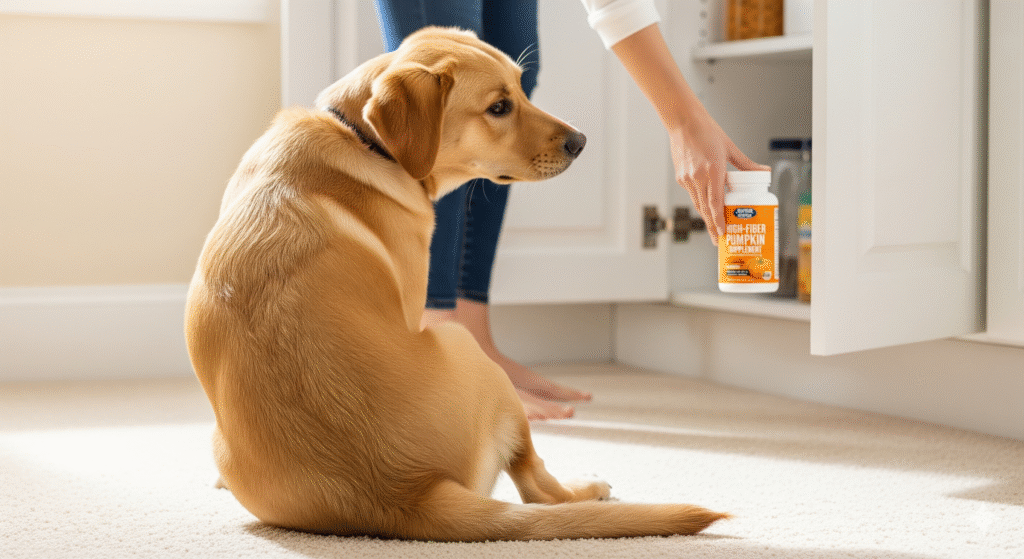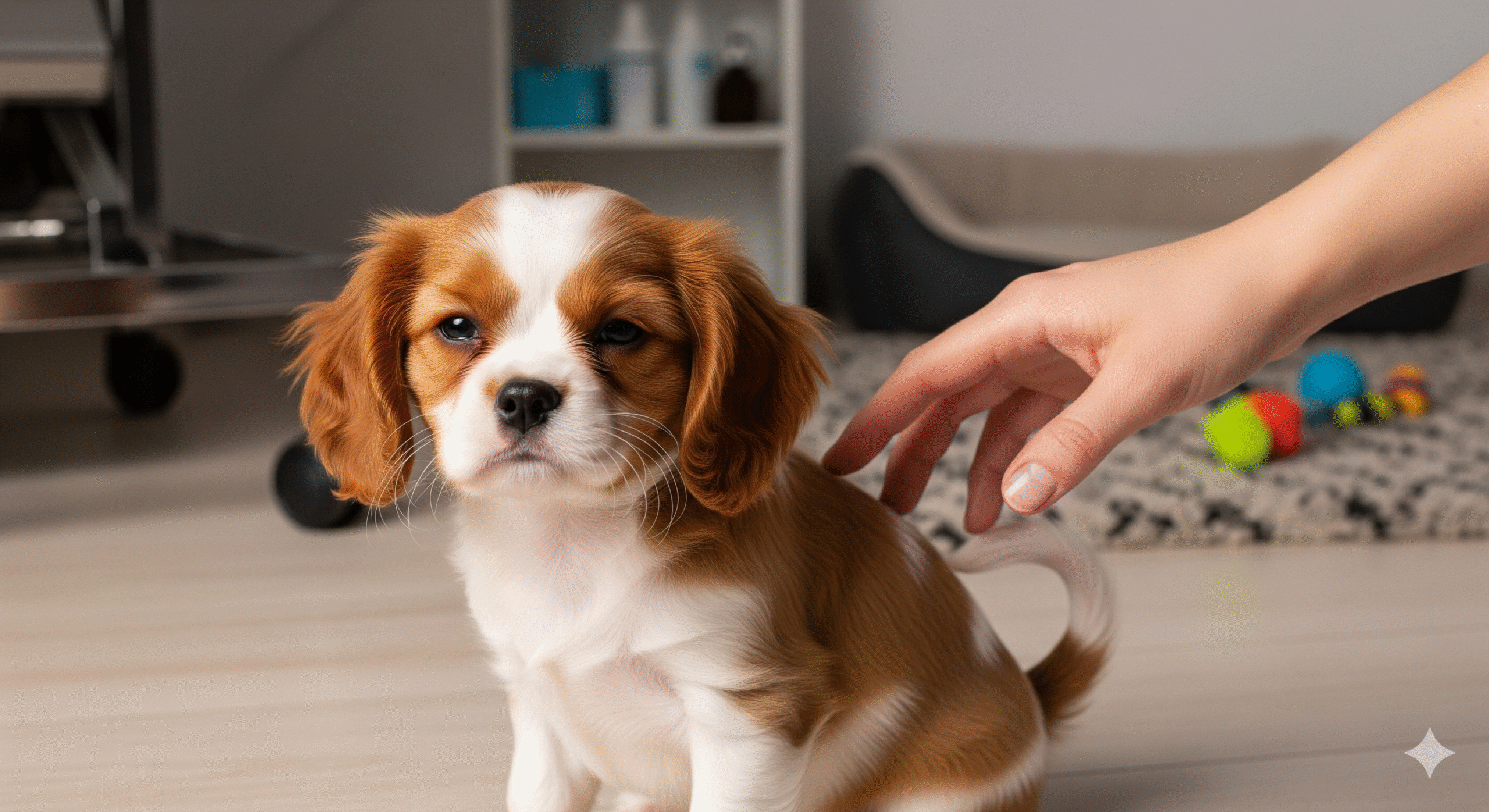It’s a scene that plays out in living rooms everywhere: your adorable puppy sits down, hikes their back legs up, and proceeds to drag their bottom across your carpet with a look of intense concentration. While it often gets a laugh, puppy scooting is a sign that something is causing irritation or discomfort around their rear end. It’s their way of trying to scratch an itch or relieve pressure that they can’t reach with their paws. Ignoring it isn’t just about saving your rug; it’s about addressing an underlying issue that could range from a simple fix to a more serious health concern.
This behavior is a message from your puppy, and this guide will help you decode it. We’ll walk through the common causes, from the very likely to the less common, and provide a clear action plan for diagnosis and treatment.
Here’s what we’ll cover:
✔️ The #1 most common reason for scooting: anal gland issues
✔️ Parasites and infections that cause intense itching
✔️ Skin allergies and irritations you might not have considered
✔️ A step-by-step guide to checking your puppy at home (safely and cleanly!)
✔️ When it’s a simple fix and when you need to call the vet immediately
✔️ Preventative measures to keep your puppy from scooting for good
Let’s get to the bottom of your puppy’s bottom issue and restore peace to your floors.
The #1 Cause: Anal Gland Problems 🫘
This is by far the most frequent reason a dog scoots. Every dog has two small, pea-sized sacs (anal glands) located on either side of their anus. They produce a foul-smelling, oily fluid that is normally expressed in small amounts during bowel movements, serving as a scent marker.
Scooting happens when these glands become impacted, infected, or full.
Why Anal Glands Become a Problem:
- Soft Stools: Puppies often have inconsistent stool quality. Firm, healthy stools naturally compress and empty the glands during defecation. Soft or loose stools don’t provide enough pressure, allowing the fluid to thicken and build up.
- Small Breed Predisposition: Smaller breeds and puppies are more prone to anal gland issues because their glands are smaller and their ducts are narrower, making them easier to block.
- Anatomy: Some dogs just have poorly positioned glands that don’t drain properly.
Signs of Anal Gland Issues:
- Scooting
- Licking or biting at the base of the tail/rectum
- A foul, fishy odor suddenly emanating from your puppy’s rear
- Visible swelling or redness on one or both sides of the anus
Other Common Causes of Puppy Scooting 🔍
1. Intestinal Parasites 🪱
- Culprits: Tapeworms are a classic cause. The segments of these worms, which look like grains of rice or sesame seeds, migrate out of the anus and can cause significant itching.
- Other Worms: Roundworms and hookworms can also cause general anal irritation.
- Action: Regular fecal exams and deworming by your veterinarian are essential.
2. Skin Allergies & Dermatitis 🤧
- Causes: Environmental allergies (pollen, dust mites) or food allergies can cause generalized itching all over the body, including around the perianal area.
- Signs: You might also see your puppy itching their paws, face, and ears.
3. Dried Stool or Matted Fur 🧻
- Cause: If stool gets stuck to the fur around the anus, it dries and becomes incredibly irritating. This is especially common in long-haired breeds.
- Fix: This is an easy one! Keep the area around your puppy’s bottom trimmed and clean. A “sanitary trim” from a groomer can work wonders.
4. Perianal Fistulas or Infections 🦠
- This is less common but more serious. It involves draining tracts and infections around the anus, which are extremely painful and require immediate veterinary treatment. German Shepherds are predisposed.
The Step-by-Step Diagnostic Guide: What to Check at Home 🩺
Warning: Wear disposable gloves and be prepared for unpleasant odors.
- The Sniff Test: Does your puppy suddenly smell fishy? This is a strong indicator of anal gland issues.
- The Visual Check:
- Gently lift your puppy’s tail.
- Look for any swelling or redness on the sides of the anus (anal glands).
- Check for dried stool or matted fur clinging to the area.
- Look for signs of tapeworm segments (small, white, moving rice-like pieces) around the anus or in their bedding.
- The Comfort Check: Does the area look clean and normal but your puppy is still scooting? It’s likely an internal issue (full anal glands, parasites) that requires a vet visit.
How to Fix the Scooting: Cause-Specific Solutions 🛠️
For Anal Gland Issues:
- Veterinary Expression: The safest and most effective solution. Your vet or groomer can manually express (empty) the glands. It is not generally recommended for owners to do this themselves unless taught by a vet, as you can cause injury.
- Dietary Changes: Increasing fiber can help create bulkier stools that naturally express the glands. Ask your vet about adding:
- Canned plain pumpkin (not pie filling)
- Psyllium husk powder (like unflavored Metamucil)
- A high-fiber prescription diet
For Parasites:
- See Your Vet: They will need a fecal sample to diagnose the specific parasite and prescribe the correct deworming medication.
For Dried Stool or Matted Fur:
- Give your puppy a “butt bath.” Use warm water and a gentle dog shampoo to soften and clean the area. A fine-tooth comb can help gently remove matted fur.
- Keep the area trimmed for hygiene.
For Allergies:
- This requires a veterinary diagnosis. Your vet may recommend an elimination diet to rule out food allergies or prescribe medication to manage environmental allergies.
When to See a Veterinarian Immediately 🚨
While often minor, scooting can signal a serious problem. Contact your vet ASAP if you see:
- Blood or pus coming from the rectum.
- Constant straining to defecate.
- A hard, painful swelling near the anus.
- Your puppy seems lethargic, in pain, or isn’t eating.
- The scooting is frequent and persistent despite your efforts to clean the area.
Final Checklist for a Scoot-Free Puppy ✅
☑️ I have checked for visible signs of irritation, worms, or matted fur.
☑️ I have noted if there is a foul, fishy odor.
☑️ I am feeding a high-quality diet to promote firm stools.
☑️ I am keeping my puppy on a regular deworming schedule.
☑️ I know when to call the vet for help.

“…The key to successful crate training is making the crate a positive, safe space. Never use it for punishment. Feed your puppy their meals in the crate and give them special toys and treats that they only get inside. If your puppy barks or whines after being crated, resist the urge to let them out immediately. Instead, wait for a moment of quiet to reward them. This teaches them that quiet behavior is what earns freedom and attention. For more in-depth strategies on handling nighttime barking specifically in the crate, we have a dedicated resource: Stop Puppy Barking at Night: 5 Quick Fixes.”






